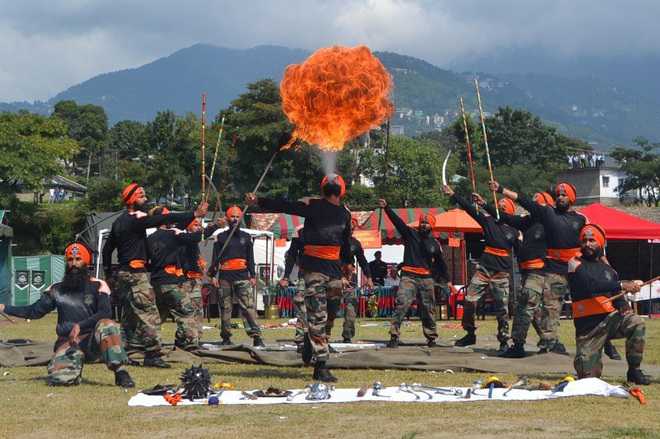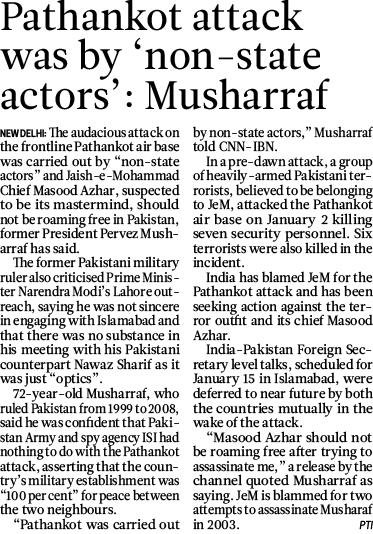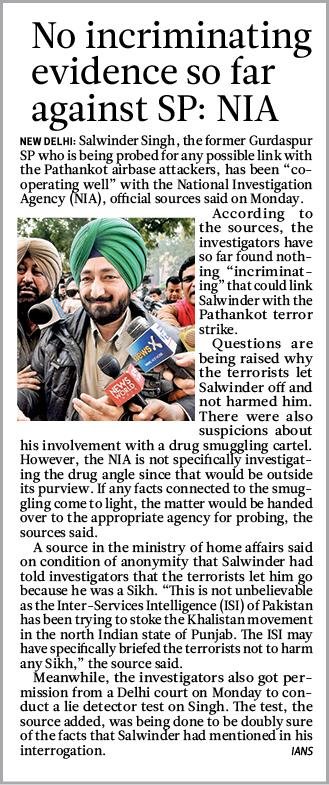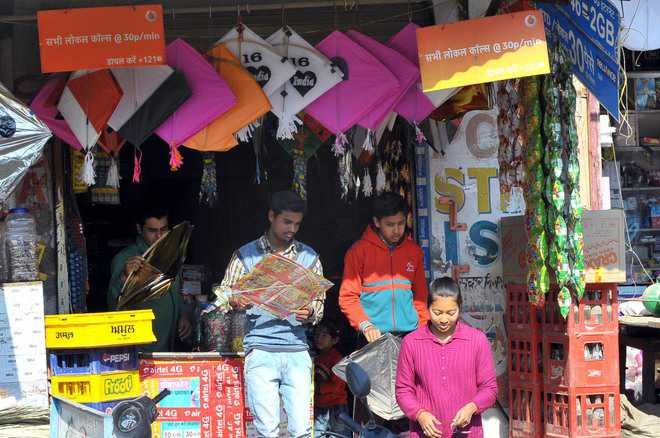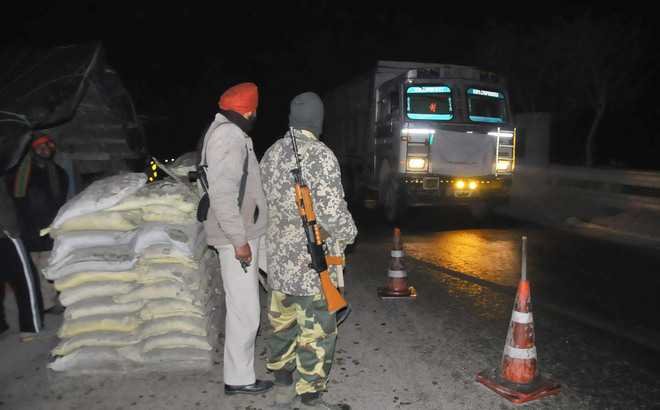Ruchika M Khanna,Tribune News Service,Chandigarh, January 7
Superintendent of Police Salwinder Singh has been given a clean chit by the Punjab government in the report prepared by it for the Union Home Ministry on the terror strike at the Air Force Station in Pathankot.The state government has also denied that there was any delay on its part in responding to the initial sighting of the terrorists.Having drawn flak for its delay in responding to the initial terror alert, it now seems that the Punjab government is covering its tracks.The Union Home Ministry had asked the state government to submit a report on how the terror strike unfolded and the state government’s initial response, after the terrorists were first sighted by the police officer.The role of the SP, who was transferred from Gurdaspur to Jalandhar as Commandant of PAP, following a complaint, only a few days before the terror strike, was questionable.His theory that he was going to pay obeisance at a dera on December 31 night and that too without a gunman has several loopholes.Besides, the fact that he was let off by the terrorists along with his cook, Madan Gopal, while their third co-traveller, jeweler Rajesh Verma, was grievously injured before being thrown out has raised many questions over the SP’s role. However, the state government’s report sent to the Government of India absolves the police officer of any wrongdoing.The initial timeline of the sequence of events, as revealed earlier this week, had said the police official after being let off had called then Senior Superintendent of Police, Gurdaspur, at 3.23 am on January 1, informing him of the incident.The district Police Chief, in spite of an alert sent on December 29, saying 16 militants might have entered the border district, refused to believe Salwinder Singh.This was initially also corroborated by Salwinder Singh himself, who had then claimed that the officer did not take him seriously and asked him to call the police control room. Initially, Salwinder had said nobody responded to his calls in the police control room till 6 am and only a DSP finally came to help him.By this time, injured Verma too was found and it was only then that the police started acting on their complaint of four “Urdu-speaking” armed terrorists having carjacked them.However, the report sent to the Home Ministry now says that there was no delay in the police response to the carjacking by terrorists.It says that the police acted immediately and even the top police brass in Chandigarh had been alerted early in the morning, within minutes of the SP’s call to the Gurdaspur SSP.”By 7 am, ADGP, Law and Order, Hardeep Singh Dhillon had already been dispatched and the police worked on parallel tracts to trace the culprits,” says the report.Interestingly, amid rumours that the police had ordered an internal investigation against four of its officers for delay in responding to the SP’s terror alert, Director General of Police Suresh Arora said no internal inquiry against any police officer had been ordered.”There was no delay on any police officers’ part and immediate search operations to trace the terrorists were launched,” he said.Admitting that the terrorists could have local handlers in the area, Arora, however, said the police was still in the process to identify the local handlers, but the search had so far been inconclusive.
CONTRADICTORY STATMENTS:What report to Home Ministry says
- The state government’s report sent to the Government of India absolves the police officer of any wrongdoing
- The report says there was no delay in the police response to the carjacking by terrorists
- It says the police acted immediately and even the top police brass in Chandigarh was alerted early in the morning, within minutes of the SP’s call to the Gurdaspur SSP
- By 7 am, ADGP, Law and Order, Hardeep Singh Dhillon had already been dispatched and the police worked on parallel tracts to trace the culprits
What SP SalwinderSingh said
- The SP’s theory that he was going to pay obeisance at a dera on Dec 31 and that too without a gunman has several loopholes
- The SP after being let off had called then SSP, Gurdaspur, at 3.23 am on Jan 1, informing him of the incident, but he refused to believe him and asked him to call PCR
- He had said nobody responded to his calls in the PCR till 6 am and a DSP finally came to help him
- By this time, injured Verma was found and it was only then that the police started acting on their complaint of four armed terrorists
Tanda woman accuses Salwinder of bigamy
Seeks rights for ‘their’ son, demands DNA test


Sanjiv Kumar Bakshi,Hoshiarpur, January 7
Superintendent of Police Salwinder Singh has landed in yet another soup after a woman from Tanda, Urmur, claiming to be his second wife, has opened a front against him seeking her son’s rights.Karanpreet Kaur has claimed that Salwinder Singh married her in April 1994 when he was an ASI in the Amritsar police.”He didn’t allow us to have the marriage photographed from a professional photographer. Instead he got it photographed from a young man accompanying him to whom he introduced as his cousin but we never saw those photographs. He told us that his mother was not well and he would inform her later. After the marriage I repeatedly asked him to take me to his home in Amritsar, but every time he made an excuse and later started quarrelling over the issue,” Karanpreet said.She claimed that she had been residing with him in capacity of his wife at various places of his postings. She had been there with him at Dera Baba Nanak, Amritsar, and other places and he used to stay with her at her parental house till September 1999 when her son was born.She alleged, “After our son was born, he started staying away from me and left us when our son was eight-month old and never looked back.”She added that when he ignored her, she filed a complaint too. “My complaints were heard and statements were recorded but nothing happened after that ever. Once a DIG-level inquiry was also conducted but that too was of no use. I was told to see the DGP, but I could not go as my son was very small,” she added.Her 16-year-old son, Angin Sahilpreet Singh, had also filed a complaint in this regard, which is still pending. Both Sahilpreet and his mother Karanpreet demanded that a DNA test of the SP should be got done to confirm their claim.”Action should be taken against him. Besides, my son should be given all rights,” she said.
Yet another controversy
- Karanpreet Kaur claims that SP Salwinder Singh married her in April 1994 when he was an ASI in the Amritsar police
- She claimed that she stayed with him at various places of his postings and he used to stay with her at her parental house till September 1999 when her son was born
- She alleged he left her when their son was eight months’ old

